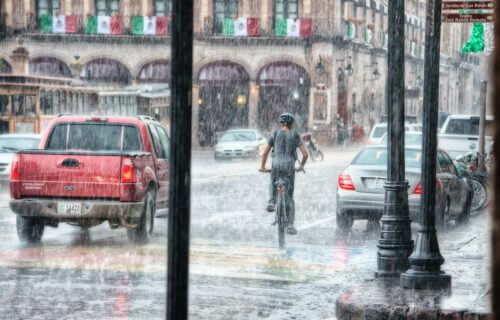EVANSTON, Ill. — A new study finds that when it rains, it really does pour. Researchers from Northwestern University say it’s actually raining harder in the United States — and climate change may be to blame.
The study found that rainfall intensity has increased in all but one region out of 17 across the U.S., with precipitation up five percent when it rains east of the Rocky Mountains. In fact, the only region not experiencing harder rainfalls includes an area along the Pacific Coast and Rocky Mountains.
Study authors say climate change may be to blame because warmer air can hold more moisture.
“When people study how climate change has affected weather, they often look at extreme weather events like floods, heatwaves and droughts,” says Northwestern’s Daniel Horton, the study’s senior author, in a media release. “For this particular study, we wanted to look at the non-extreme events, which are, by definition, much more common. What we found is pretty simple: When it rains now, it rains more.”
How is rainfall changing over time?
The team compared two climatologically distinct time periods, 1951-1980 and 1991-2020. For each period, they examined historical precipitation data from the Global Historical Climatology Network, a public database created by the National Oceanic and Atmospheric Administration.
They then studied these observations within the 17 distinct climate regions across the country. These areas in America vary in temperature, precipitation, vegetation, and ecosystem dynamics. Results show that precipitation intensity — which includes rain and snow — has increased over time, especially in the East, South, and Midwest.
“Not only do we see increasing precipitation intensity for regions east of the Rockies,” says first author Ryan Harp, “but the intensities are becoming more variable as well, making water resource management even more challenging.”
Although the study does not definitively blame climate change for changes in precipitation rates, Harp notes that their findings line up with global warming and climate model predictions that measure the damage humans are doing to the planet.
“Warmer air holds more moisture,” the researcher explains. “For every one degree Celsius the atmosphere warms, it holds 7% more water vapor. So these observations are consistent with the predicted effects of human-caused global warming.”
“You don’t need an extreme weather event to produce flooding,” Horton concludes. “Sometimes you just need an intense rainstorm. And, if every time it rains, it rains a little bit more, then the risk of flooding goes up.”
The study is published in the Geophysical Research Letters.

